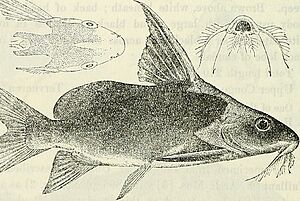Synodontis clarias facts for kids
Quick facts for kids Synodontis clarias |
|
|---|---|
 |
|
| Conservation status | |
| Scientific classification | |
| Genus: |
Synodontis
|
| Species: |
clarias
|
The Synodontis clarias, also known as the red-tailed synodontis or mandi, is a special kind of upside-down catfish. You can find this fish in many rivers and lakes across northern Africa. A famous Swedish scientist named Carl Linnaeus first described it in 1758. The first fish he studied came from Egypt, near the city of Cairo. The name clarias might mean "bright" or "clear," but we are not completely sure.
Contents
Discovering the Red-Tailed Synodontis
What Does It Look Like?
Like all fish in the Synodontis family, the red-tailed synodontis has a strong, bony head. This bony part goes all the way back to its first dorsal fin spine. It also has a unique bony bump on its head called a humeral process. The shape and size of this bump help scientists tell different Synodontis species apart. For the S. clarias, this bump is flat, rough, and shaped like a triangle.
This fish has three pairs of barbels, which are like whiskers. One pair is on its upper jaw, and two pairs are on its lower jaw. The upper jaw barbels are straight and have thin branches. They can be almost as long as the fish's head. The outer pair of lower jaw barbels is longer than the inner pair and also has thin branches.
Special Fins and Teeth
The front edges of the dorsal fin (on its back) and pectoral fins (on its sides) are hard, stiff spines. The dorsal spine is usually as long as or a bit longer than its head. It is curved and has jagged edges on both sides. The rest of the dorsal fin has seven soft rays and a short, thin tip. The pectoral fin spine is shorter than the dorsal spine and also has jagged edges.
The adipose fin is a small, fleshy fin without rays, located near the tail. It is about 3 to 4.5 times longer than it is deep. The anal fin (on its underside) has five unbranched rays and seven to nine branched rays. Its front part is sharply pointed. The tail fin, also called the caudal fin, has a deep notch, and its upper part is longer.
All Synodontis fish have a special pad of teeth on the very front of their upper jaw. These teeth are short and shaped like chisels. The S. clarias has only a few of these teeth, usually in one, two, or three rows. On its lower jaw, the teeth are attached to flexible stalks and look like an "S" shape or a hook. The number of teeth on the lower jaw helps identify the species. The S. clarias usually has about 6 to 9 teeth there.
Colors and Size
The red-tailed synodontis is typically grey to green on its back and white on its belly. Its fins are greyish-white, and its tail often has a red tip, which gives it its common name! Young fish might have small, dark swirly patterns on their bodies and round dark spots on their belly, anal, and tail fins.
This fish can grow up to about 36 centimeters (about 14 inches) long. Generally, female Synodontis fish tend to be a little bigger than males of the same age.
Where Does the Red-Tailed Synodontis Live?
Its Home and Diet
In the wild, you can find the red-tailed synodontis from Senegal all the way to Ethiopia, and throughout the entire Nile River. People often catch this fish for food. Sadly, its home is facing problems like dams, less water, and water pollution.
In its natural environment, this fish is a bottom feeder. This means it searches for food at the bottom of rivers and lakes. It eats things like insect larvae, plants, and tiny bits of decaying matter.
How Does It Reproduce?
Scientists don't know much about how most Synodontis species reproduce. However, we do know that female S. clarias can carry many eggs. They likely lay their eggs during the flooding season, which is usually between July and October. During this time, pairs of fish are thought to swim together when they lay their eggs. Young fish grow very quickly in their first year, and then their growth slows down as they get older.


